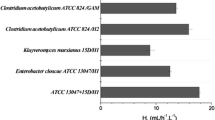Abstract
Conversion of food waste into hydrogen by thermophilic acidogenesis was investigated as a function of organic loading rate (OLR), hydraulic retention time (HRT) and pH in a continuous stirred tank reactor. In order to identify hydrogen-producing microorganisms, denaturing gradient gel electrophoresis (DGGE) of the polymerase chain reaction (PCR) – amplified V3 region of 16S rDNA analysis was conducted at each tested pH. The conversion of food waste into hydrogen was strongly influenced by the operational conditions. The hydrogen production was increased as OLR increased up to 8 gVSl-1 d-1, but drastically decreased at 10 gVSl-1 d-1. The yield of hydrogen was decreased from 2.2 to 1.0 mol-H2/mol-hexose consumed as HRT decreased from 5 to 2 days. More carbohydrates in the food waste were decomposed at longer HRT, 76–90%, at HRT of 2–5 days. The hydrogen production peaked at pH 5.5 ± 0.1 and significantly decreased at pH 5.0 ± 0.1. The biogas produced was composed of hydrogen and carbon dioxide, but no methane was detected at all tested conditions. The hydrogen contents in the gas produced were more than 55% (v/v) and not sensitive to all tested conditions. The optimum operational condition for continuous hydrogen production from the food waste was obtained at 8 gVSl-1d-1, 5 days HRT and pH 5.5 ± 0.1 where the hydrogen production rate, content, yield and the efficiency of carbohydrate decomposition were 1.0 l H2/l-d, 60.5% (v/v), 2.2 mol-H2/mol-hexose consumed and 90%, respectively. The hydrogen production was related with the concentration of total organic acids (TOA) which was strongly dependent on that of butyrate indicating that the reaction was mainly butyrate fermentation. The hydrogen-producing microorganism of Thermoanaerobacterium thermosaccharolyticum that involved in acetate/butyrate fermentation, was detected with strong intensity at all tested pHs by denaturing gradient gel electrophoresis (DGGE) of the polymerase chain reaction (PCR) – amplified V3 region of 16S rDNA analysis and sensitive to the tested pHs. The experimental results indicated that effective hydrogen production from the food waste could be obtained continuously by thermophilic acidogenesis at proper operational condition.
Similar content being viewed by others
References
APHA (1992) Standard Methods for the Examination of Waste and Wastewater,18th ed American Public Health Association, Washington
Chang FY & Lin CY (2004) Biohydrogen production using an up-flow anaerobic sludge blanket reactor. Int. J. Hydrogen Energy 29(1): 33–39
Dubois M, Gilles KA, Hamilton JK, Rebers PA & Smith F (1956) Calorimetric method for determination of sugars and related substance. Anal.Chem. 28(3): 350–356
Fang HHP & Liu H (2002) Effect of pH on hydrogen production from glucose by a mixed culture. Bioresour. Technol. 82: 87–93
Ginkel SV, Sung S & Lay JJ (2001) Biohydrogen production as a function of pH and substrate concentration. Environ. Sci. Technol. 35(24):4726–4730
Horiuchi JI, Shimizu T, Tada K, Kanno T & Kobayashi M (2002) Selective production of organic acids in anaerobic acid reactor by pH control. Bioresour. Technol. 82: 209–213
Lay JJ (2000) Modelling and optimization of anaerobic digested sludge converting starch to hydrogen. Biotechnol. Bioeng. 68(3): 269–278
Lay JJ, Lee YJ & Noike T (1999) Feasibility of biological hydrogen production from organic fraction of municipal solid waste. Water Res. 33(11): 2579–2586
Mata-Alvarez J, Mace S & Liabres P (2000) Anaerobic digestion of organic solid wastes. An overview of research achievements and perspectives. Bioresour. Technol. 74: 3–16
Mizuno O, Dinsdale R, Hawkes FR, Hawkes DL & Noike T (2000) Enhancement of hydrogen production from glucose by nitrogen gas sparing. Bioresour. Technol. 73:59–65
Noike T & Mizuno O (2000) Hydrogen fermentation of organic municipal wastes. Water Sci. Technol. 42(12): 155–162
Okamoto M, Miyahara T, Mizuno O & Noike T (2000) Biological hydrogen potential of materials characteristic of the organic fraction of municipal solid wastes. Water Sci. Technol. 41(3): 25–32
Ueno Y, Otsuka S & Morimoto M (1996) Hydrogen production from industrial wastewater by anaerobic microflora in chemostat culture. J. Ferment Bioeng. 82(2): 194–197
Ueno Y, Haruta S, Ishii M & Igarashi Y (2001a) Microbial community in anaerobic hydrogen-producing micro flora enriched from sludge compost. Appl. Microbiol. Biotechnol. 57: 555–562
Ueno Y, Haruta S, Ishii M & Igarashi Y (2001b) Characterization of a microorganism isolated from the effluent of hydrogen fermention by microflora. J. Biosci. Bioeng. 92(4): 397–400
Van Haandel AC & Lettinga G (1994) Anaerobic Sewage Treatment - A Practical Guide for Regions with a Hot Climate. Wiley, New York
Yu H, Zhu Z, Hu W & Zhang H (2002) Hydrogen production from rice winery wastewater in an upflow anaerobic reactor by using mixed anaerobic cultures. Int. J. Hydrogen Energy 27: 1359–1365
Yu H & Fang HHP (2000) Thermophilic acidification of dairy wastewater. Appl. Microbiol. Biotechnol. 54: 439–444
Zhang T, Liu H & Fang HHP (2003) Biohydrogen production from starch in wastewater under thermophilic condition. J. Environ. Manage. 69(2): 149–156.
Author information
Authors and Affiliations
Rights and permissions
About this article
Cite this article
Shin, Hs., Youn, Jh. Conversion of food waste into hydrogen by thermophilic acidogenesis. Biodegradation 16, 33–44 (2005). https://doi.org/10.1007/s10531-004-0377-9
Issue Date:
DOI: https://doi.org/10.1007/s10531-004-0377-9




